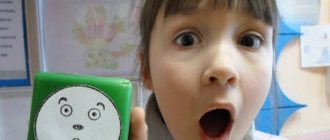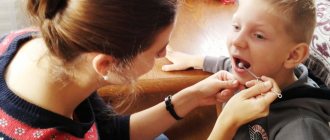Slurred speech or erased dysarthria? Speech therapist advice
It happens that parents and teachers scold the child for inattention, reduce grades for missing letters and for vague answers in class. But the problem is not laziness or inattention, but functional disorders of the nervous system. Doctor of Pedagogical Sciences, professor, speech therapist Elena Arkhipova spoke about erased dysarthria - unintelligibility of speech caused by organic reasons - on the online platform of the Institute of Additional Vocational Education for Social Workers.
Dysarthria is not a purely childhood problem; speech impairment can also occur in adults. And in this case, the help of a speech therapist is also necessary. Let's figure out what dysarthria is, what its causes are and how to work with it.
The exact definition will sound like this: dysarthria is a violation of sound pronunciation and prosody due to a violation of the innervation of the muscles of the speech apparatus. And two more unfamiliar words at once! We'll figure it out further
Prosody is the intonation expressiveness of speech. It is expressed in the rate of speech, voice modulations, intonation, logical stress, etc.
Innervation is a neurological term meaning the conduction of nerve impulses from the brain to the muscles.
It turns out that dysarthria has organic causes, that is, it is associated with disorders in the development of the nervous system. This means that work with her must begin not at the speech therapy level, but at the neurological level. Actually, dysarthria is only a symptom signaling damage to the nervous system.
Causes of dysarthria in children:
- intrauterine pathology;
- birth injuries;
- Rh conflict between child and mother;
- traumatic brain injuries, etc.
Causes of dysarthria in adults:
- cerebrovascular accident;
- traumatic brain injury;
- brain tumors.
Where does work with disarty begin?
The first stage is medical. It is performed by a neurologist. In the arsenal of doctors - the necessary medications, physiotherapy, therapeutic massage, reflexology, in short, means aimed at strengthening the central nervous system and eliminating pathological symptoms.
The second stage is psychological and pedagogical. A whole team of specialists participates in it: educators, defectologists, psychologists, speech therapists. It is important to involve parents too. The goal of this stage is the development of sensory functions, spatial representations, gross motor skills, and fine motor skills.
The third stage is the actual speech therapy stage. A speech therapist eliminates dysarthria in individual sessions.
Erased dysarthria is the most common disorder in preschoolers and primary schoolchildren. Unfortunately, the diagnosis is not always made. Parents and teachers scold the child for inattention, lower grades for missing letters and for unclear answers in class. But it often turns out that the student diligently completes homework, learns the rules and does not make grammatical errors, but misses letters in writing and speaks in monosyllables. His problem is not laziness or inattention, but functional disorders of the central nervous system. And he cannot cope with this with a simple effort of will.
Before starting work with such a child, the speech therapist needs to carefully understand the causes of the problem, and only then choose correction methods.
Tests to identify erased dysarthria.
- For static coordination of movements. Ask your child to stand on one leg for a few seconds. Then to another.
- For dynamic coordination of movements. You need to hit the target with a small ball. For example, into another ball.
- Another dynamic task: jump over a stretched elastic band.
- To study the speed of movements. The child should, at your command, sit on the floor and stand up without using his hands.
- For motor memory. Repeat the series of simple movements shown by you in exactly the sequence and at the speed that you specified.
- For simultaneity of movements. Wind the thread onto the spool while walking in place.
Research shows that children with erased dysarthria have deviations from the standards for all these indicators.
Please note that these tests are not aimed at diagnosing speech development, but at motor skills. The fact is that the development of psychomotor skills is significantly ahead of the development of speech and thinking. Motor development is the basis for the formation of higher mental functions. That is why correctional work with dysarthria begins with the formation of motor skills - general, manual, finger, facial. There is a whole range of exercises to help specialists: finger games, a “magic bag”, performing familiar everyday activities with eyes closed, origami, appliqué, adaptive physical education and much more. The main thing is to remember: the sooner you identify and start working with erased dysarthria, the fewer difficulties the child will have at school, and then in adult life. After all, illegible speech greatly complicates communication, and sometimes even interferes with the choice of profession.
Watch even more webinars from the Institute of Additional Vocational Education on the “I’m at home” portal in the “Online workshops” section
Press service of the Department of Labor and Social Protection of the Population of Moscow
How to help a child with erased dysarthria in kindergarten
Dysarthria is a disorder of sound pronunciation, voice formation and prosody, caused by insufficient innervation of the muscles of the speech apparatus: the respiratory, vocal and articulatory departments.
Erased dysarthria (mild degree of dysarthria, MDD - minimal dysarthric disorders) in speech therapy practice is one of the most common and difficult to correct disorders of pronunciation of speech.
Erased dysarthria occurs very often in preschoolers and schoolchildren. The main complaints with erased dysarthria are the following: slurred, inexpressive speech, poor diction, distortion and replacement of sounds in words with a complex syllable structure, and others. Children with severe dysarthria need long-term, systematic individual speech therapy assistance.
Erased dysarthria is most often diagnosed after five years. All children whose symptoms correspond to erased dysarthria are referred for consultation to a neurologist to clarify or confirm the diagnosis and to prescribe adequate treatment, because in case of erased dysarthria, the method of correctional work should be comprehensive and include: medical intervention; psychological and pedagogical assistance; speech therapy work.
For early detection of erased dysarthria and proper organization of complex effects, it is necessary to know the symptoms that characterize this disorder. When examining a child aged 5-6 years with erased dysarthria, the following features and negative symptoms are revealed:
GENERAL MOTOR SKILLS. Children with severe dysarthria are characterized by motor clumsiness. Some people have a limited range of active movements. Muscles quickly tire during functional loads. They stand unsteadily on one leg, cannot jump on one leg, walk along a “bridge”, etc. They imitate movements poorly: how a soldier walks, how a bird flies, how bread is cut, etc. Motor incompetence is especially noticeable in physical education and music classes, where children lag behind in tempo, rhythm of movements, as well as in switching movements.
FINE MOTOR SKILLS OF THE HAND. Children with erased dysarthria late and have difficulty mastering self-care skills: they cannot button a button, untie a scarf, etc. During drawing classes, they don’t hold a pencil well and their hands are tense. Many people don't like to draw. Motor clumsiness of the hands is especially noticeable during applique classes and with plasticine. In works on appliqué, difficulties in the spatial arrangement of elements can also be traced. Violation of fine differentiated movements of the hands is manifested when performing sample tests of finger gymnastics. Children find it difficult or simply cannot perform an imitation movement without outside help, for example, “lock” - put their hands together, intertwining their fingers; “rings” - alternately connect the index, middle, ring and little fingers with the thumb and other finger gymnastics exercises and others
During origami classes they experience great difficulties and cannot perform the simplest movements, because... both spatial orientation and subtle differentiated hand movements are required. Many children under 5-6 years old are not interested in playing with construction sets, do not know how to play with small toys, and do not assemble puzzles.
Children with severe dysarthria may experience difficulties in mastering graphic skills already in the first grade. Some children exhibit “mirror writing.” For example, there may be a replacement of the letters “d” with “b”. It is possible to replace vowels and word endings when writing. Poor handwriting and slow writing speed are often noted.
Erased dysarthria, which in preschool age mainly manifests itself in unintelligible speech, is complicated by difficulties in mastering written speech at school age. This is a large number of errors in writing and difficulties in mastering reading. All this hinders the successful development of the school curriculum. At the same time, speech therapists, kindergarten teachers and parents can, even in the preschool period, help a child with erased dysarthria and eliminate violations that interfere with clear and intelligible speech, as well as remove the preconditions for violations in children’s written speech.
FEATURES OF THE ARTICULATING APPARATUS. In children with erased dysarthria, pathological features in the articulatory apparatus are revealed. Some children experience muscle flaccidity (pareticity, hypotension).
Muscular hypotonia of the organs of articulation is manifested in the following: the face is hypomimic (weak facial expressions), the facial muscles are flaccid. There is lethargy of the masticatory muscles; children chew poorly. The mouth is often open, the lips are flaccid, their corners are drooping. During speech, the lips remain flaccid, which worsens the intonation-expressive side of speech. The child's tongue is at the bottom of the mouth, flaccid, the tip of the tongue is inactive.
There are other symptoms when muscle tone is increased (spasticity). At the same time, the face is amicable (there are no facial reactions), the facial muscles are tense. The lips of such a child are constantly in a half-smile: the upper lip is pressed against the gums. During speech, the lips do not take part in the articulation of sounds. Many children who have similar symptoms do not know how to perform the “tube” articulation exercise, that is, stretch their lips forward and others. With increased tone, the tongue is often thick, without a pronounced tip, and inactive.
SOUND PRONUNCIATION. When examining sound pronunciation, the following are revealed: confusion, distortion of sounds, replacement and absence of sounds. But, unlike dyslalia (a simple violation of sound pronunciation), speech with erased dysarthria has, in addition to disturbances in sound pronunciation, disadvantages in the prosodic side of speech, that is, disturbances in the intonation-expressive coloring of speech.
Impaired pronunciation and prosody affect speech intelligibility, intelligibility, and expressiveness. The examination reveals that many children who distort, omit, mix or replace sounds can pronounce these same sounds correctly in isolation. The most common disorder is a defect in the pronunciation of whistling and hissing sounds.
Quite often, such defects in sound pronunciation as interdental pronunciation and lateral overtones are noted. Children have difficulty pronouncing words with a complex syllabic structure; they simplify the sound content of words by omitting some sounds when consonants are combined.
PROSODICA. The intonation-expressive coloring of the speech of children with erased dysarthria is sharply reduced. The voice, vocal modulations in pitch and strength suffer, speech exhalation is weakened. The timbre of speech is disrupted and sometimes a nasal tone of speech appears. The pace of speech is often accelerated. When reciting a poem, the child’s speech is monotonous, gradually becomes less intelligible, and the voice fades away. The children's voice during speech is quiet, modulation in pitch and voice strength is not possible (the child cannot change the pitch of the voice by imitation, imitating the voices of animals: cows, dogs, etc.).
In some children, speech exhalation is shortened, and they speak while inhaling. In this case, speech becomes choked.
Quite often, children with good self-control are identified who, during a speech examination, do not show deviations in sound pronunciation, because They pronounce the words in a chant, that is, syllable by syllable. At the same time, prosody disturbances are expressed, which affects the communicative function of speech, and the child’s ability to communicate verbally with other children and with adults deteriorates.
GROUPS OF CHILDREN WITH ERASED DYSARTHRIA. Children with mild dysarthria are a heterogeneous group. Depending on the level of development of linguistic means, children belong to different groups.
So, if sounds and prosody are disturbed, and the vocabulary of speech is rich and grammatically correct, then such a child will be included in the group with phonetic disorders (FN).
If, in addition to disturbances in sounds and prosody, a child’s phonemic hearing is also impaired, then such a child with erased dysarthria will already be classified in the group with phonetic-phonemic underdevelopment (FFN).
Phonemic awareness is the ability to identify and distinguish phonemes of the native language at the word level. The ability to distinguish sounds is normally formed in a child from 6 months of age to 1 year 7 months.
In the same case, when a child’s speech is poorly developed and there is a poor vocabulary, pronounced disturbances in the formation of the syllabic structure of words and the grammatical structure of speech, and in addition there is also a gross violation of sound pronunciation and prosody, then in this case the child will be assigned to a group with a general speech underdevelopment (OND).
COMPLEX IMPACT. To eliminate erased dysarthria, a complex intervention is required, including medical, psychological, pedagogical and speech therapy.
Medical impact is determined by a neurologist. Treatment should include drug therapy, exercise therapy, reflexology, massage, physiotherapy and others.
Psychological and pedagogical influence is carried out by psychologists, educators, parents and speech therapists in group classes. Psychological and pedagogical influence should be aimed at the development of sensory functions; clarification of spatial representations; formation of constructive praxis; stereognosis, development of higher cortical functions; formation of subtle differentiated hand movements; formation of cognitive activity; psychological preparation of the child for school.
The speech therapy direction is implemented by a speech therapist teacher in special individual speech therapy classes that take into account the specific characteristics of a child with erased dysarthria.
Literature
- Arkhipova E.F. Erased dysarthria in children (textbook) M.: AST-Astrel, 2006.
- Arkhipova E.F. Correctional and speech therapy work to overcome erased dysarthria (textbook) M.: Astrel, (series “Speech therapist’s library”) 2008.
- Arkhipova E.F. Speech therapy massage for dysarthria (textbook). M.: Astrel (series “Library of Speech Therapist”), 2008.
Arkhipova E.F. Doctor of Pedagogical Sciences, Professor at Moscow State Pedagogical University, Moscow.







